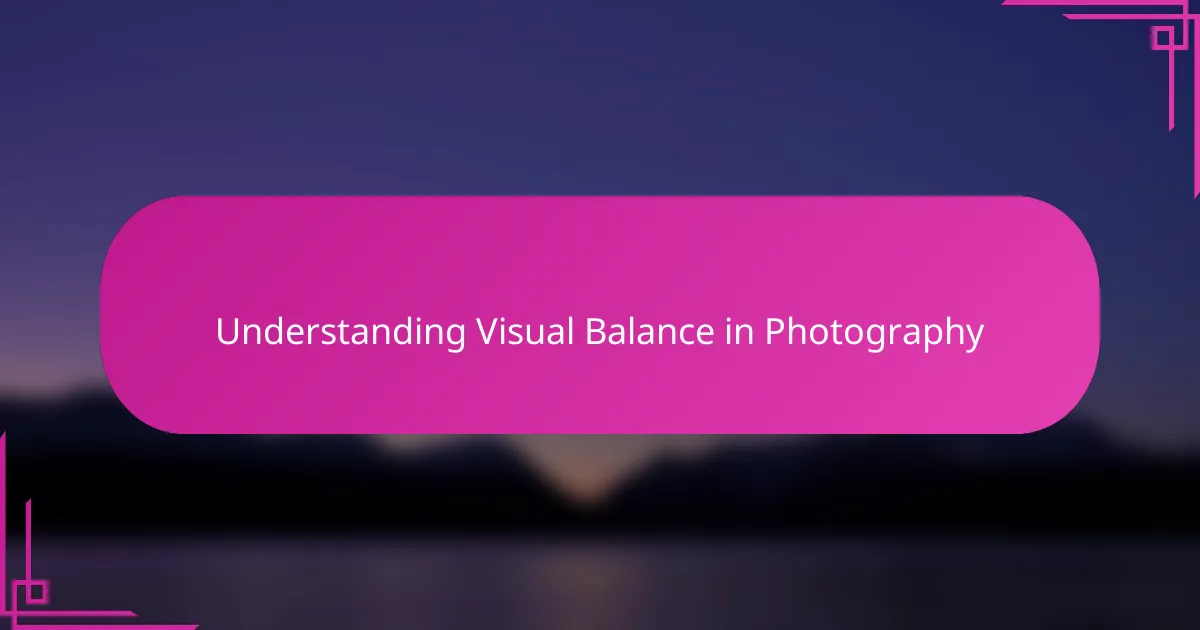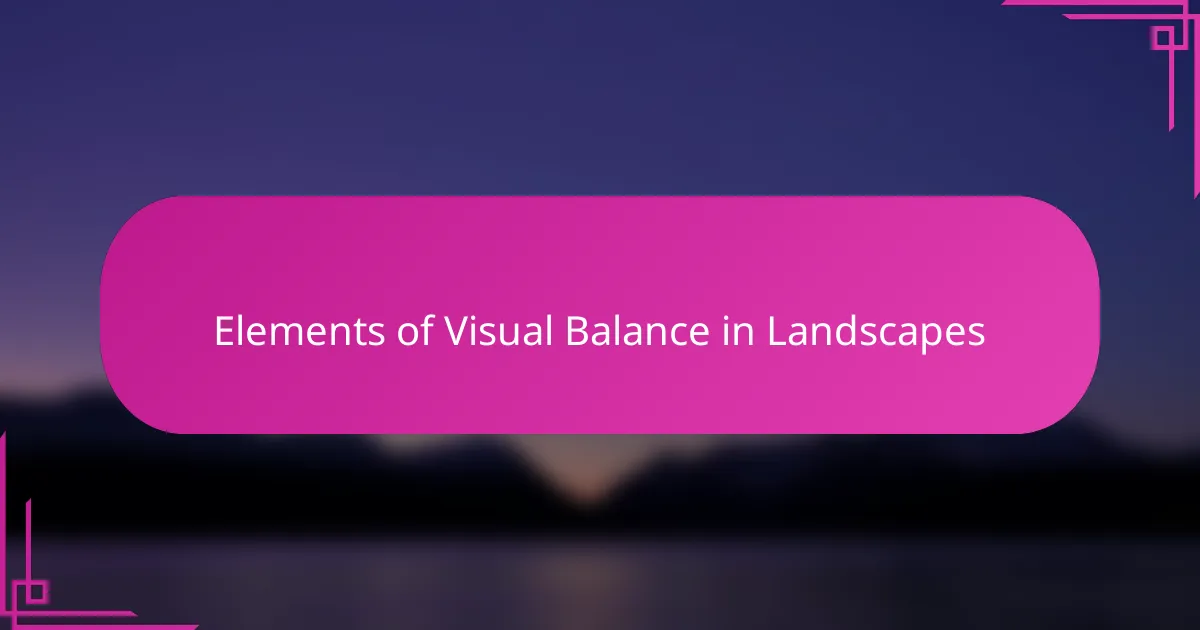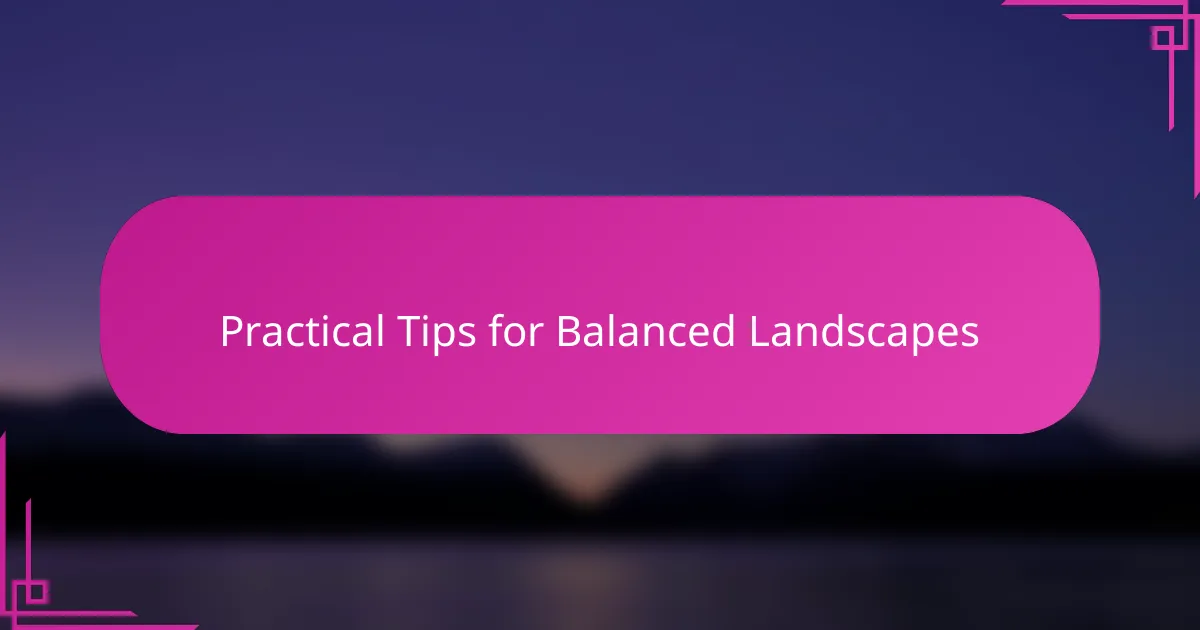Key takeaways
- Visual balance in photography is about distributing visual weight for stability and harmony, not just symmetry.
- Key elements for achieving balance include shapes, colors, textures, and the placement of dominant subjects alongside smaller details.
- The rule of thirds and careful attention to light distribution can significantly enhance the composition’s natural balance.
- Editing can fine-tune visual balance by adjusting cropping, brightness, and color grading to guide the viewer’s eye effectively.

Understanding Visual Balance in Photography
When I first started capturing landscapes, I didn’t fully grasp what visual balance meant, but over time, I realized it’s like a silent dialogue between elements in a frame. How do you feel when a photo seems to pull your eyes effortlessly from one point to another? That feeling of ease usually comes from balanced composition.
Visual balance isn’t just about symmetry; it’s about distributing visual weight so the image feels stable yet dynamic. For instance, I once shot a sunset where a lone tree stood off-center, yet the vivid colors on the opposite side gave the photo a natural harmony that I found deeply satisfying.
I often ask myself: Does this shot feel calm or chaotic? That question helps me decide if I’ve achieved balance. It’s in these moments, when everything just clicks visually, that I feel my connection with a scene deepen, making the photograph more than just a picture.

Elements of Visual Balance in Landscapes
One element I find crucial in achieving visual balance is the distribution of shapes and masses. When I’m out in the field, I notice how a large rock on one side can be offset by a cluster of smaller bushes on the other. It’s fascinating how our eyes naturally seek this equilibrium, even if the elements aren’t perfectly symmetrical.
Color also plays a surprising role. I remember capturing a misty morning where a patch of bright wildflowers balanced the dark silhouette of a hill across the frame. That contrast created a subtle tension that felt just right—enough to hold my gaze without overwhelming me. Have you ever caught yourself drawn to a photo because of a simple splash of color?
Then there’s texture and detail, which often go unnoticed but quietly anchor the image. Streaks in the clouds or ripples in water add layers that complement other elements. I’ve learned to pay attention to these nuances because they often turn a good shot into one that feels complete and thoughtfully composed.

Techniques to Achieve Visual Balance
One technique I rely on is the rule of thirds, which breaks the scene into a grid to place key elements off-center. It’s amazing how shifting a subject just slightly from the middle can create a more natural and inviting balance. Have you ever noticed how a perfectly centered horizon sometimes feels static, but when it’s aligned with one of these grid lines, the composition breathes?
Another approach I often use is balancing a dominant visual element with smaller, less obvious ones. For example, I once photographed a vast mountain on one side of the frame, and instead of mirroring it, I found a small, bright patch of flowers on the other side that grounded the image. That little detail acted like a visual counterweight, making the whole photograph feel harmonious without forcing symmetry.
Lastly, I pay close attention to color and light distribution across the frame. When the light shifts or the colors change, the visual weight does too—which can either support or disrupt balance. I remember a cloudy day when a sudden burst of sunlight illuminated a distant tree, pulling my eye across the image and adding a dynamic but balanced focal point. Have you experienced how natural light can quietly orchestrate the harmony in your photos?

Common Mistakes in Landscape Composition
It’s easy to fall into the trap of overcrowding a scene with too many competing elements. I’ve made this mistake myself—thinking more detail always meant a stronger photo—only to realize the image became confusing and restless. Have you ever looked at a landscape where nothing feels to rest on, and wondered why?
Another common pitfall is neglecting the placement of the horizon. Early on, I often centered it without much thought, but that rigid choice robbed many shots of their potential energy. Why does a flat horizon sometimes make a landscape look dull? Because it fails to invite the eye to wander naturally.
Finally, ignoring the balance of light and shadow can upset the entire composition. There was a time I captured a dramatic storm scene where half the frame was nearly black, and the rest brightly lit—only, it didn’t feel balanced at all. It taught me that managing contrast isn’t just technical; it’s about guiding the viewer’s attention with intention.

Analyzing My Landscape Photos
When I review my landscape photos, I often zoom in on how the visual weight is balanced across the frame. Sometimes, I catch myself drawn to one side more than the other and realize the composition feels lopsided. Have you ever experienced that subtle discomfort when your eyes hesitate on where to rest within a photo?
I remember going through a folder of shots from a foggy morning and noticing that the images with a single strong element—like a silhouetted tree or a rock—felt empty unless paired with a secondary detail that provided counterbalance. That insight pushed me to be more intentional about including those quieter, smaller elements to anchor the scene.
Another thing I consider is the interplay of light and shadow when analyzing my photos. One evening, I discovered that a subtle highlight on a distant ridge completely changed the mood and balance of the image, pulling my gaze gently across the frame. It’s these moments that remind me composing a balanced landscape is as much about timing as it is about framing.

Practical Tips for Balanced Landscapes
One practical tip I always rely on is scouting the scene carefully before hitting the shutter. Sometimes stepping a few feet to the left or right can shift elements just enough to create a natural balance. Have you ever felt that little spark of satisfaction when everything in your frame just seems to settle perfectly? That moment often comes from this slight repositioning.
I also make it a habit to use foreground elements intentionally. Placing an interesting rock or a patch of grass close to the camera can counterbalance vast, open spaces in the background. It’s like giving your eyes a place to land before they explore the rest of the landscape, which can make the whole composition feel grounded and harmonious.
Another technique I find invaluable is simplifying the scene. I remind myself to remove distractions—whether it’s a stray branch or a cluttered patch of leaves—that pull attention away from the main subject. It’s amazing how often less truly becomes more, turning a scattered image into one that feels calm and perfectly balanced. Have you ever noticed how calm a photo feels when every element earns its spot?

Enhancing Visual Balance Through Editing
When I’m editing landscape photos, I often think of it as a final chance to fine-tune the visual balance that sometimes slips away in the field. Have you ever noticed how a slight crop or a small adjustment in brightness can totally shift where your eye travels first? I find that by gently nudging those elements, I can transform a decent image into one that feels much more harmonious.
Color grading is another editing tool I lean on heavily. For example, I once enhanced the warmth in the foreground while subtly cooling the background shadows—this contrast created a push-and-pull effect that made the scene feel both balanced and alive. It’s fascinating how tweaking colors can subtly redistribute visual weight without changing the actual composition.
And then there’s the power of selective sharpening or softening. By sharpening a main subject like a striking tree and softly blurring less important areas, I guide the viewer’s attention naturally, reinforcing the photograph’s equilibrium. Have you tried this before? It’s like gently orchestrating a visual dance where every step feels intentional and well-placed.